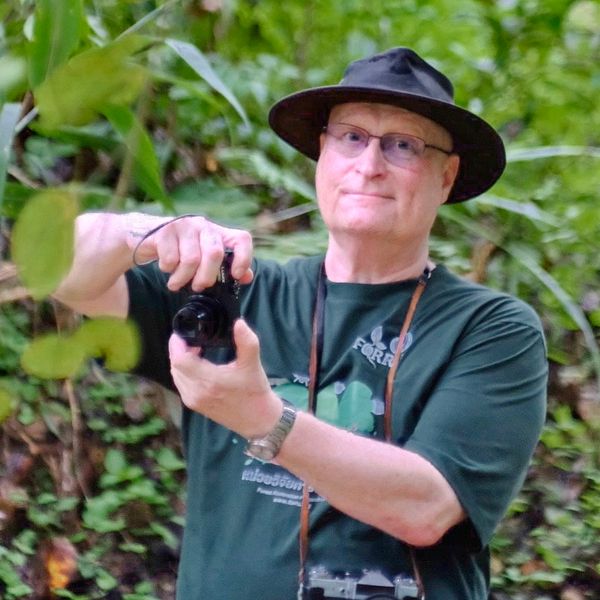ตีพิมพ์ครั้งแรกใน Guidelines Magazine (2002)
ในโลกที่มีประชากรเพิ่มขึ้นอย่างรวดเร็ว ดูเหมือนว่าป่าเขตร้อนจะถูกทำลายอย่างต่อเนื่องเพื่อตอบสนองความต้องการของมนุษย์ที่เพิ่มมากขึ้นอย่างหลีกเลี่ยงไม่ได้ หากเป็นเช่นนั้น เราก็ต้องยอมรับด้วยว่าความหลากหลายทางชีวภาพของโลกจะหายไปเป็นจำนวนมาก เนื่องจากป่าเขตร้อนเป็นที่อยู่อาศัยของพืชและสัตว์มากกว่าครึ่งหนึ่งของโลก
แต่บางทีอนาคตอาจไม่ได้เลวร้ายขนาดนั้น ตัวอย่างกรณี ชาวเขาเผ่าม้ง จากบ้านแม่สาทางตอนเหนือของอุทยานแห่งชาติดอยสุเทพ-ปุย ร่วมกับหน่วยวิจัยการฟื้นฟูป่า มหาวิทยาลัยเชียงใหม่ แสดงให้เห็นถึงการฟื้นคืนของป่าเขตร้อนจากพื้นที่ที่เสื่อมโทรมที่มีการตัดไม้ทำลายป่า ชาวบ้านสามารถอาศัยอยู่ในพื้นที่หุบเขาเล็กๆ แห่งนี้ได้ โดยขณะเดียวกันยังคงมีการเพิ่มขึ้นของจำนวนประชากรในหมู่บ้าน ปัจจุบันชาวบ้านเริ่มได้รับผลตอบแทนจากการทำงานอย่างหนักเพื่อการดูแลรักษาป่า โดยการเชิญชวนนักท่องเที่ยวเชิงนิเวศให้มาเพลิดเพลินกับป่าที่ได้รับการฟื้นฟูนี้
หมู่บ้านแม่สาเป็นชุมชนชาวเขาเผ่าม้งที่ใหญ่ที่สุดในภาคเหนือของประเทศไทย โดยมีครัวเรือนมากกว่า 200 หลังคาเรือน จำนวนประชากรที่เพิ่มขึ้นในหมู่บ้านทำให้ทรัพยากรธรรมชาติในหุบเขาได้รับผลกระทบอย่างหนัก อย่างไรก็ตาม ชุมชนได้เริ่มกิจกรรมการเพิ่มพื้นที่ป่าไม้ในลุ่มน้ำตั้งแต่ปี พ.ศ. 2539 ป่าดั้งเดิมกลับเจริญเติบโตบนพื้นที่เสื่อมโทรมเหนือหมู่บ้านที่ซึ่งเคยเป็นแหล่งปลูกกะหล่ำปลีและแครอท หลังจากมีการฟื้นตัวของป่า ทั้งต้นไม้และสัตว์ป่ากำลังกลับมาอีกครั้ง
ในอดีต ชาวม้งปลูกข้าวโพดเป็นอาหารเลี้ยงสัตว์ ข้าวไร่เป็นอาหารหลัก และปลูกฝิ่นเพื่อหารายได้ แม้ว่าจะมีข้อโต้แย้งกันอย่างมาก เมื่อการปลูกฝิ่นมีประโยชน์ในเชิงนิเวศน้อยมาก แต่เนื่องจากฝิ่นให้กำไรดี แต่ละครอบครัวจึงมีการถางป่าบางส่วน เพียงแปลงเล็กๆ เพื่อปลูกฝิ่นสร้างรายได้ตอบสนองต่อความต้องการพื้นฐานของตนเอง อย่างไรก็ตาม เมื่อเทียบกับต้นทุนทางสังคมจากการติดยาเสพติดทำให้มีนโยบายในการยุติการปลูกฝิ่น ในช่วงทศวรรษ 1980 โครงการปราบปรามยาเสพติดหันมาส่งเสริมการปลูกพืชเกษตรทางเลือก (แต่ให้ผลกำไรน้อยกว่ามาก) ชาวบ้านต้องถางป่าที่เหลือเกือบทั้งหมดเพื่อให้ได้รายได้ที่เพียงพอ โดยสงวนไว้เพียงป่าที่เหลืออยู่เพียงเล็กน้อยบนเนินที่ลาดชันที่สุด ปัญหาที่ต้องเผชิญ คือ การเกิดไฟป่าในช่วงฤดูแล้ง ซึ่งได้เผาผลาญพื้นดิน ในขณะที่ในช่วงมรสุม ฝนที่ตกหนักได้ชะล้างดินชั้นบนของเนินที่ปลูกพืชและลงมาปิดทับลำธารด้วยตะกอน ส่งผลให้น้ำประปาในชุมชนแห้งเหือด ชาวบ้านจึงต้องย้ายถิ่นฐานไปอยู่ในหุบเขาซึ่งยังคงมีลำธารสามสายไหลมาจากผืนป่าที่ยังหลงเหลืออยู่ พวกเขาเริ่มตระหนักว่าการอนุรักษ์ป่าต้นน้ำเล็กๆ แห่งนี้มีความสำคัญต่อการดำรงชีวิตของพวกเขา นอกจากนี้ การพัฒนาที่สำคัญอีกประการหนึ่งเกิดขึ้นในปี พ.ศ. 2524 เมื่อหุบเขานี้ได้รับการประกาศให้เป็นส่วนหนึ่งของอุทยานแห่งชาติดอยสุเทพ-ปุย ชาวบ้านต้องพิสูจน์ให้ทางการเห็นว่าพวกเขาสามารถดูแลสิ่งแวดล้อมได้เพื่อหลีกเลี่ยงการถูกขับไล่ออกจากอุทยาน

หน่วยวิจัยการฟื้นฟูป่า (FORRU) ก่อตั้งขึ้นในปี พ.ศ. 2537 เพื่อพัฒนาวิธีการที่เหมาะสมในการฟื้นฟูระบบนิเวศป่าธรรมชาติในพื้นที่เสื่อมโทรม เพื่อการอนุรักษ์สัตว์ป่าและการปกป้องพื้นที่ป่าต้นน้ำ ในช่วงแรก หน่วยงานได้ดำเนินการศึกษาความรู้พื้นฐานทางด้านนิเวศวิทยาของพันธุ์ไม้พื้นเมืองกว่า 680 ชนิดบนดอยสุเทพ บันทึกชีพลักษณ์ ช่วงเวลาการติดดอกออกผลตามฤดูกาลของพันธุ์ไม้เกือบ 100 ชนิด และทำการทดสอบการงอกของพันธุ์ไม้กว่า 400 ชนิด และยังได้ทำงานร่วมกับ Horticulture Research International (HRI) ของอังกฤษ ทำการทดลองเพื่อพัฒนาวิธีการที่มีประสิทธิภาพในการปลูกพันธุ์ไม้พื้นเมืองจากเมล็ดให้มีขนาดที่เหมาะสมสำหรับการปลูกอีกด้วย
หน่วยวิจัยการฟื้นฟูป่าได้เริ่มพัฒนาแนวทางการฟื้นฟูป่าโดยใช้ “พรรณไม้โครงสร้าง” ซึ่งเป็นต้นไม้ที่เร่งการฟื้นตัวตามธรรมชาติของป่าเมื่อปลูกในพื้นที่เสื่อมโทรม ไม้เหล่านี้ต้องอยู่รอดและเติบโตอย่างรวดเร็วภายใต้สภาวะที่รุนแรง และสามารถสร้างเรือนยอดอย่างรวดเร็ว ให้ร่มเงาช่วยบดบังวัชพืช ต้นไม้ที่ปลูกไม่เพียงช่วยฟื้นฟูโครงสร้างและหน้าที่ของป่า แต่ยังเร่งการฟื้นตัวของความหลากหลายทางชีวภาพด้วยการผลิตอาหาร แหล่งทำรัง หรือทรัพยากรอื่นๆ ในช่วงเวลาไม่กี่ปีหลังการปลูก ซึ่งจะดึงดูดสัตว์ป่าที่กระจายเมล็ดพันธุ์ให้กลับเข้ามาในพื้นที่ พืชที่เติบโตจากเมล็ดซึ่งสัตว์ป่ากระจายพันธุ์เข้าไปในพื้นที่ปลูกจะค่อยๆ ฟื้นฟูพืชพรรณในป่าดั้งเดิม
ในลำดับต่อมา คือ การค้นหาพื้นที่ที่สามารถทดสอบศักยภาพของพันธุ์ไม้โครงสร้างได้ ดังนั้น เมื่อทางอุทยานขอให้หน่วยวิจัยฯ ช่วยเหลือชาวบ้านแม่สาใหม่ปลูกป่าบนพื้นที่ลุ่มน้ำตอนบน จึงเป็นโอกาสในการผสมผสานความต้องการในเชิงวิทยาศาสตร์กับความต้องการของชุมชนท้องถิ่น นอกจากนี้ ชาวบ้านยังขอให้หน่วยวิจัยฯ ช่วยสร้างเรือนเพาะชำกล้าไม้ของชุมชนด้วย หน่วยวิจัยฯ จึงสนับสนุนการสร้างเรือนเพาะชำกล้าไม้ประจำหมู่บ้าน และช่วยฝึกอบรมชาวบ้านบางส่วนให้สามารถดำเนินกิจกรรมต่างๆในเรือนเพาะชำ เรือนเพาะชำชุมชนแห่งนี้ทำให้นักวิจัยของหน่วยวิจัยฯ ได้พิจารณาว่าชาวบ้านซึ่งไม่มีพื้นฐานทางวิทยาศาสตร์จะยอมรับเทคนิคการผลิตกล้าไม้ที่พัฒนาขึ้นในสถานที่วิจัยหรือไม่ ซึ่งในท้ายที่สุด ข้อเสนอแนะจากชาวบ้านให้แนวคิดมากมายสำหรับการวิจัยเพิ่มเติม
ในปี พ.ศ. 2539 โครงการทดลองวิธีการพรรณไม้โครงสร้างก็พร้อมที่จะเริ่มการวิจัยอย่างจริงจังในภาคสนาม ซึ่งในแต่ละปี ได้มีการทดสอบปลูกพรรณไม้โครงสร้าง 30 ชนิด ผสมผสานกันในแปลงฟื้นฟู ด้วยการสนับสนุนจากโครงการวิจัยและฝึกอบรมความหลากหลายทางชีวภาพของประเทศไทยและโครงการอีเดนของอังกฤษ แปลงปลูกเหล่านี้มีการทดลองเพื่อทดสอบว่าต้นไม้ที่ปลูกตอบสนองต่อการควบคุมวัชพืช การใส่ปุ๋ย และการคลุมดินแบบต่างๆ อย่างไร เนื่องจากแปลงทดลองมีขนาดค่อนข้างเล็ก ชาวบ้านจึงได้มีการปลูกต้นไม้ในพื้นที่ขนาดใหญ่ขึ้นเพื่อเป็นกิจกรรมของชุมชนด้วย
ภัยคุกคามที่ร้ายแรงที่สุดต่อต้นไม้ที่ปลูก คือ ไฟป่าที่มักจะเกิดขึ้นในฤดูแล้ง ดังนั้นในช่วงกลางเดือนมกราคม ทุกครอบครัวในหมู่บ้านจะช่วยกันทำแนวกันไฟรอบแปลงและเข้าร่วมทีมลาดตระเวนดับไฟ จนกว่าฝนจะเข้าสู่ฤดูฝนอีกครั้ง ชาวบ้านถือว่าการป้องกันไฟเป็นกิจกรรมที่สำคัญมาก โดยที่พวกเขามักจะประกอบพิธรกนนมขอพรจากวิญญาณผู้พิทักษ์เพื่อขอโชคลาภในช่วงเริ่มต้นฤดูไฟป่า หากว่ากิจกรรมการป้องกันไฟประสบความสำเร็จ ในช่วงต้นฤดูฝนชาวบ้านจะร่วมกันขอบคุณวิญญาณผู้พิทักษ์ โดยการประกอบพิธีกรรม มีการไหว ถวายหมู
เมื่อสิ้นสุดฤดูฝนที่สองหลังจากการปลูก ต้นไม้สูงขึ้นและเริ่มมีการปกคลุมของเรือนยอดไม้ ชาวบ้านได้ร่วมประเมินความสำเร็จที่เกิดขึ้นจากการทำงานอย่างหนัก กับทีมงานหน่วยวิจัยฯ เพื่อวัดขนาดต้นไม้ที่ปลูก มีการบันทึกการกลับเข้ามาของพันธุ์ไม้ในป่า นอกจากนี้ยังมีการสำรวจทุกเดือนเพื่อบันทึกว่าต้นไม้ต้นใดที่มีดอกและผลดึงดูดสัตว์ให้กลับเข้ามาในแปลงฟื้นฟูอีกด้วย
ผลลัพธ์ที่ได้นั้นชัดเจนมาก ภายใน 2-3 ปีหลังจากปลูกต้นไม้ พื้นที่ที่ร้อน แห้งแล้งและเสื่อมโทรม ถูกปกคลุมด้วยวัชพืช ได้เปลี่ยนเป็นป่าที่เย็นและร่มรื่นพร้อมกับพื้นป่าที่เต็มไปด้วยใบไม้ร่วงเป็นพรม ต้นไม้บางชนิดที่ปลูก เติบโตรวดเร็วสูงได้ถึง 7 เมตร ภายในเวลาเพียง 18 เดือนหลังจากปลูก และสัตว์ป่า เช่น หมูหริง หมูป่า กวาง และนกป่าจำนวนมากได้กลับเข้ามาในพื้นที่อีกครั้ง

เมื่อเรื่องราวความสำเร็จของโครงการการฟื้นฟูแพร่กระจายออกไป ก็เริ่มมีนักท่องเที่ยวที่อยากรู้อยากเห็นเข้ามาเรื่อยๆ ทุกครั้งที่มีแขกมาเยือน คณะกรรมการอนุรักษ์หมู่บ้านจะออกมาอธิบายว่าเหตุใดชุมชนจึงมีส่วนร่วมอย่างลึกซึ้งในการอนุรักษ์ป่าไม้ ความเชื่อมโยงระหว่างคุณภาพของสิ่งแวดล้อมและมาตรฐานการครองชีพ ซึ่งชาวบ้านแม่สาใหม่มองเห็นได้ชัดเจนในปัจจุบัน มักต้องอธิบายให้ผู้มาเยือนทราบอย่างอดทน ชาวบ้านดูภูมิใจที่ชุมชนของตนได้รับการยอมรับในฐานะต้นแบบขององค์กรต่างๆ มากมาย ในปี 2543 บ้านแม่สาใหม่เป็นเจ้าภาพจัดการประชุมนานาชาติเรื่อง “การฟื้นฟูป่าเพื่ออนุรักษ์สัตว์ป่า” ตั้งแต่นั้นมา กลุ่มผู้เยี่ยมชม ประกอบมักด้วยนักข่าววิทยุ นักป่าไม้ นักศึกษา องค์กรพัฒนาเอกชน ครู เจ้าหน้าที่รัฐ และสมาคมเยาวชนชาวม้งในภูมิภาค เป็นต้น

ปัจจุบันชาวบ้านกำลังทำการพัฒนาโปรแกรมการท่องเที่ยวเชิงนิเวศของตนเอง โดยได้รับความช่วยเหลือจากโครงการหลวง ศูนย์การท่องเที่ยวเชิงนิเวศ ซึ่งกำลังอยู่ระหว่างการก่อสร้างและพัฒนาโปรแกรมเพื่อให้ผู้เยี่ยมชมได้สัมผัสกับแหล่งท่องเที่ยวทางธรรมชาติและวัฒนธรรมของหุบเขาแม่สา ผู้เยี่ยมชมจะได้พักในบ้านพักเล็กๆ ที่กำลังก่อสร้างอยู่ในหมู่บ้าน และเพลิดเพลินกับกิจกรรมต่างๆ มากมาย เช่น เดินป่า ดูสัตว์ป่า และดูดาวในบริเวณที่กางเต็นท์ท่ามกลางต้นไม้ที่ปลูกไว้
© Stephen Elliott & David Blakesley: ข้อมูลและภาพ, 2002.
นับตั้งแต่บทความนี้ได้รับการตีพิมพ์ครั้งแรกในปี 2545 แปลงป่าฟื้นฟูที่ปลูกไว้ตั้งแต่ปี 2539-2556 บนลุ่มน้ำเหนือบ้านแม่สาก็ยังคงเติบโตต่อไป นก สัตว์เลี้ยงลูกด้วยนม และพืชต่างๆ หลายชนิดก็กลับมามีชีวิตอีกครั้ง แม้ว่าไฟป่าจะยังคงเกิดขึ้นบ้าง แต่ชาวบ้านก็รีบดับไฟป่าอย่างรวดเร็ว ทำให้พื้นที่ของไฟป่าลดลง นอกจากสิ่งอำนวยความสะดวกสำหรับนักท่องเที่ยวเชิงนิเวศที่จัดทำขึ้นโดยโครงการหลวงแล้ว ชาวบ้านบางส่วนยังจัดตั้งรีสอร์ทท่องเที่ยวเชิงนิเวศขนาดเล็กไว้ใต้แปลงที่ปลูกไว้ เพื่อให้นักท่องเที่ยวได้เดินเล่นในป่าฟื้นฟู ชมนก และชมทัศนียภาพอันงดงาม





